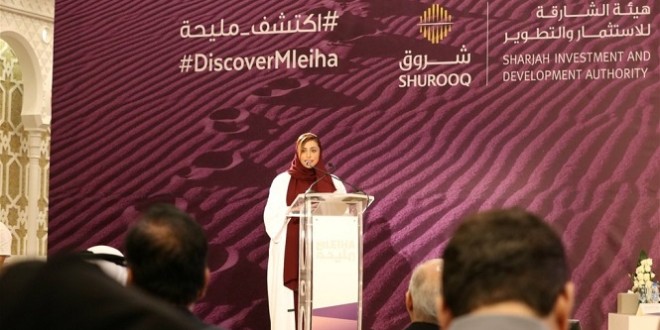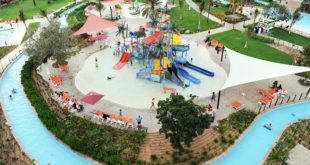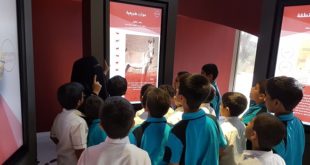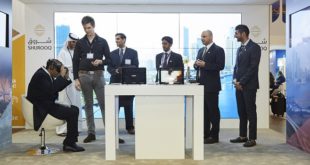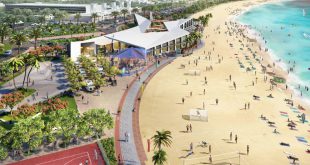Details of the completed phase one of the Mleiha Archaeological and Eco-tourism Project have been revealed today by Sharjah Investment and Development Authority (Shurooq). The multiphase project will create a new tourist attraction in the UAE and the wider Arab region with an estimated AED 250 million (US$ 68m) expected to be invested in Mleiha over the next few years.
The Mleiha tourist destination, one of the most important archeological sites in the UAE, has been created in the vicinity of various ruins and burial sites that date back to ancient times, some more than hundred thousands of years.
Speaking at the press conference to unveil Mleiha Archaeological and Eco-tourism Project, Sheikha Bodour bint Sultan Al Qasimi, Chairperson of Shurooq , said: “I am very happy to be here to announce the launch of the Mleiha Archaeological and Eco-tourism Project. I am particularly delighted because I know that this project will add value to Sharjah and the UAE generally. Twenty years ago I wrote my theses in anthropology and archeology. During that time Dr Sabah Jassim was supervising my thesis and he is among us today to present details of Mleiha as the Director of the Sharjah Directorate of Antiquities.
Sheikha Bodour went on to say the choosing to develop and protect Mleiha was a very important decision as it is a living memory of our heritage and an integral part of our future. She said, “Launching this project reflects the keenness of our leadership to protect our heritage and preserve our Emirati identity. In this way we preserve our cultural history and ensure its place history. We intend to work towards promoting this important historical site in order to both protect it and bring visitors to it.”
HE Marwan bin Jassim Al Sarkal, CEO of Shurooq , gave a detailed presentation about the first phase of the Mleiha Archaeological and Eco-tourism Project, which will be officially opened by His Highness Sheikh Dr Sultan bin Muhammad Al Qasimi, Member of the Supreme Council and Ruler of Sharjah, on Wednesday 27th January 2016. He said that the development of the project is in line with His Highness’ determination to develop the Central and Eastern regions. It also forms part of Shurooq ‘s commitment to developing world-class tourist projects by improving investment opportunities with the aim of achieving social, cultural, environmental and economic development. This follows the Sharjah Tourism Vision 2021 set out by the Sharjah Commerce and Tourism Development Authority (SCTDA).
Al Sarkal said, “The project is implemented under the directives of His Highness the Ruler of Sharjah and provides a new focal point in Shurooq ‘s strategy to attract investment to the Central and Eastern regions of Sharjah and create job opportunities for the local community. The project aims to highlight tourist and historical attractions, introduce the region’s rich cultural legacy and archaeological heritage and attract visitors, particularly nature and heritage lovers to the emirate of Sharjah.”
The first phase will see the opening of the Mleiha Archaeological Centre, designed to allow visitors to gain a deeper insight in a fun and interactive manner. The building is designed to cater to the needs of tourists and provide them with information about Mleiha’s landmarks. The centre will have archaeological finds on display, informative and educational displays with historical facts about the region, a café and lounges, interactive screens that display documentaries about Mleiha’s history, signboards with details about the area, a store for the brand “I Love Sharjah”, service facilities and administration offices.
According to Al Sarkal, the centre will be a starting point for people visiting the Mleiha Archaeological and Eco-tourism Project will offer guided tours. Al Sarkal also said the project will house a range of archaeological sites, such as the Umm an-Nar Tomb, the Valley of the Caves, the Mleiha Fort, historic horse and camel graveyard, the ancient farmhouse with kitchen, the pre-Islamic Mleiha Palace.
“The project includes a variety of natural terrain, such as mountains and desert, and there is also considerable diversity of rare plants in the region. We are currently conducting a host of studies and research with relevant bodies to find ways to increase and protect the plant diversity, which characterizes the area. The project is expected to attract thousands of visitors, particularly nature and heritage lovers, to introduce them to the region’s rich archaeological heritage,” Al Sarkal added.
There will be various sporting activities such as the Adrenaline Adventures with dune buggies and quad biking activities. Visitors will also be taken on tours to seven main tracks around the site including the Fossil Rock, Camel Rock tour and the Valley of the Caves. Visitors will have the opportunity to camp out and undertake environment friendly off-road activities in 4X4 cars. Among other activities there will also be guided walks on camel trails to see the paths ancient civilizations took to cross the desert.
“Our key markets include Emirati families for picnicking, camping and desert driving, professional residents of various nationalities and independent overseas tourists and holiday tour groups,” added Al Sarkal. “The project will provide a range of exploratory sporting activities, such as the “Struggle for Survival” camp, Horse-riding Tours, Walking and Bicycling trips and the “Stranded Family” camp. Special programme of visits will be allocated for archeology lovers and college students.”
Al Sarkal revealed that Shurooq will soon embark of phase two of the Mleiha project in collaboration with relevant partners. The second phase will involve the construction of Mleiha National Desert Park over an area of 450 square kilometres. The park will serve as a wildlife reserve that will see the release of a range of animals such as the Oryx, gazelles and the mountain deer, in collaboration with the Sharjah Environment and Protected Areas Authority (EPAA).
Shurooq allocated three areas within the project to be designated for resorts and bed and breakfast style hotels which will be offered to investors who want to benefit from promising opportunities available in the Mleiha Archaeological and Eco-tourism Project and the Central Region. The second phase will also include the setting up of the Night Camping Park, which will be fully equipped to cater to the needs of camping lovers, in addition to a motel for overnight stays. Development work is underway to renovate old buildings at the site to serve as a motel within the project.
Phase Two will also see the establishment of an astronomy observatory in cooperation with the Sharjah Centre for Astronomy and Space Sciences, allowing for enthusiasts to enjoy the stars and sky from the center of Mleiha. Telescopes will be installed on the roof to allow tourists to get a glimpse of the stars and the wonders of space from Mleiha’s location.
Eng Khalid bin Butti Al Muhairi, Director of Planning and Survey Department, said, “Mleiha Archaeological and Eco-tourisml Project is the fruits of the efforts deployed by Sheikha Bodour Al Qasimi. It is a very important addition to the tourist sector and we relied on our partners to make this project successful. This follows the directives of His Highness Sheikh Dr Sultan bin Muhammad Al Qasimi, Member of the Supreme Council and Ruler of Sharjah who first defined provisions for the Emirate in 1969, including an archeological provision. The most recent plan was issued in 2006, from the Directorate of Planning and Survey to secure and promote Archeological finds and all projects in Sharjah. We are very pleased today to see this plan develop and we wish everyone involved great success because Sharjah deserves all our efforts.”
Dr Sabah Jassim, Director of the Sharjah Directorate of Antiquities who is overseeing the excavations gave presentation saying that the archaeological sites of Madam and Mleiha and their neighbouring mountains are of global importance as they provide us with a glimpse of our history from almost hundred thousands of years.
“Mleiha was the cradle of rural life, and an essential part of trade routes. It was in contact with other civilizations in the Mediterranean, South Asia and Mesopotamia, as well as with the southern northern and eastern parts of the Arabian Peninsula, as well as Eastern Arabia,” he said.
Dr Jassim explained the reason for the strategic location of the findings may be due to its route towards the trade network. “Some findings date back more than one million years, and to the pre Islamic times. It is located between the sea of Oman and the Arabian Gulf, on a strategic route towards trade routes,” he said.
“We have found more than 300 skeletons including those of horses and camels. There have been very many significant relics found in the burial sites that are the remains of daily life including some pottery and iron tools. In the caves we found antiquities that back 125 thousand years BC. This coincides with human immigration from Africa.”
Highlighting other aspects of site Dr Jassim spoke about some of the ruins found at Mleiha. He said, “In 1991 the fort was discovered and due to its very thick walls we know this was a building designed for defense. Here we found molds for coins and many coins indicating this was an important administrative building and suggests it was the centre of governance for the region. We are working tirelessly to bring more attractions and findings for tourists.”
HE Khalid Jassim Al Midfa, Chairman of Sharjah Commerce and Tourism Development Authority (STCDA), stated: “The Mleiha Archaeological and Eco-Tourism Project plays a key role in Sharjah’s diversified projects to boost its tourism sector. Additionally, the Mleiha Archaeological Centre will offer both visitors and tourists a new and unique experience to Sharjah as one of the most significant tourism destinations in the region. Finally, the project will play an influential role in leading the region’s eco-tourism and archaeological tourism sector.”
The Mleiha Archaeological and Eco-tourism Project is a collaboration by Shurooq with the Planning and Survey Department, the Environment and Protected Areas Authority in Sharjah, and the Directorate of Antiquities at the Sharjah Department of Culture and Information. It is unique tourist destination due to its natural beauty, diversity of rare wildlife and its archaeological discoveries which has seen it nominated by UNESCO as a World Heritage Site. The project will also help preserve the outstanding archaeological sites that date back to the third millenniums BC, and also protect rare wild animals, such as the Arabian Tahr, the Arabian Oryx, sand gazelle (Al Reem), and Damani gazelles and ostriches. It also gives tourists an opportunity to enjoy an exciting adventure from one of the three luxury hotels that will be set up there, and to explore archaeological treasures and rich ecological and biodiversity in Mleiha and its surrounding areas.
(Press Release)

